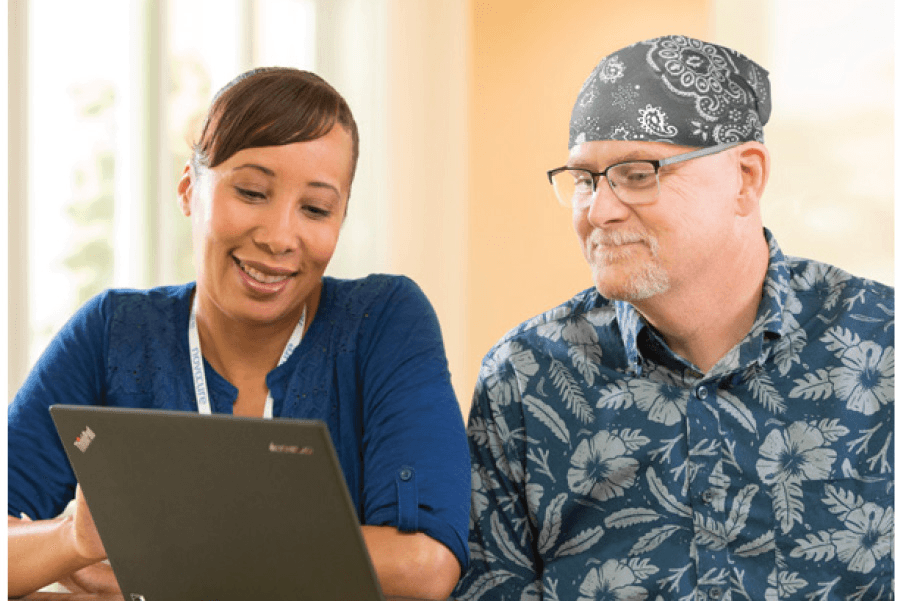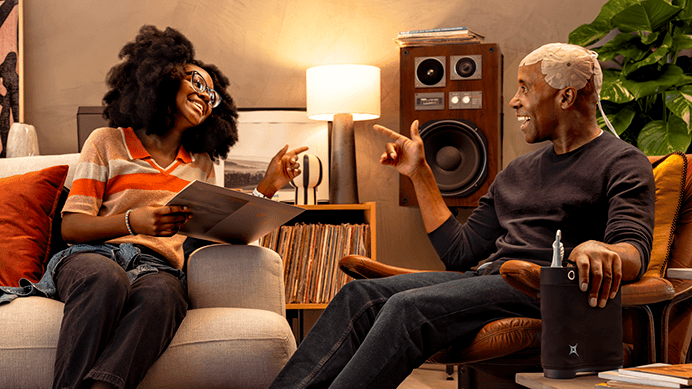
MyNovocure®
Around-the-clock support, when and where you need it

the support program that is always within reach
Anytime, Anywhere: The support your patients can count on
Whether they are at home, at work, or even on a mountain trail, MyNovocure provides a unique support system that patients can rely on at every stage of their treatment.
What is MyNovocure?
MyNovocure is an all-encompassing support program created to provide patients and their families with direct, personalized assistance. Through a combination of device support specialists (DSSs), 24/7 resources, and easy access to educational and troubleshooting materials, MyNovocure empowers patients to integrate Optune Gio into their daily routines.
Key components of MyNovocure
Travel support
Insurance support
Tips for integrating Optune Gio into daily life
24/7 technical support and troubleshooting
Device training as needed (how Optune Gio works, side effects, etc)
Reordering supplies (eg, arrays + batteries)

Taylor is an Optune Gio user and Patient Ambassador. Patient images reflect the health status of the patient at the time each photo was taken.
The MyNovocure program is more than a support system—it is a partner in your treatment journey, helping patients live confidently and comfortably with Optune Gio, no matter where life takes them.
Personalized on-demand support
For many patients, navigating a new treatment can be daunting. MyNovocure offers the peace of mind that comes with always having an expert just a call away. Each Device Support Specialist (DSS) is trained not only in the technical aspects of Optune Gio but also in providing compassionate, patient-centered support. This means that patients can feel comfortable reaching out, knowing their questions will be met with understanding and expertise.
Flexibility to match patients’ lives
The MyNovocure program isn’t confined to a clinic or limited to office hours—it is an “anytime, anywhere” resource, designed to fit seamlessly into patients’ lives. This makes Optune Gio a manageable part of their treatment plan, helping them integrate it into their daily routines with minimal disruption.
Empowerment through education and support
By combining real-time support with a full library of resources, MyNovocure gives patients and caregivers the knowledge they need to use Optune Gio effectively. Patients are empowered to become active participants in their own care, equipped with the information and confidence needed to embrace Optune Gio.
MyNovocure provides 24/7 assistance for your practice and patients throughout the treatment journey
Contact us any time of day
Call us 24/7
Or email us:
MyNovocure cannot provide any medical advice. To ensure proper guidance, MyNovocure will direct your patients to ask any treatment-related questions to you.
Partnering with your patients and practice at every step of the journey

Steve is a patient. Erica is his MyNovocure Device Support Specialist (DSS). Patient image reflects the health status of patient at the time photo was taken.
From prescription to ongoing treatment, Novocure offers patients a seamless journey of support. Starting with easy certification and submission, the Novocure team guides each patient through benefits investigation and personalized onboarding. Once treatment begins, Device Support Specialists provide live training and 24/7 assistance, with monthly check-ins and resources to help integrate Optune Gio into daily life. With MyNovocure®, patients receive the guidance they need to confidently navigate each step of their journey.
For Your Practice
Step 1: Get certified
- Reach out to a Territory Manager to complete an in-person or online certification
Step 2: Submit the prescription form
- Complete and submit all pages of the prescription form with the necessary documentation listed below via fax, email, or paper form. Patient MRI for the array map should be submitted at this time.
- Copy of patient insurance card
- Medical records (history and physical)
- Clinical notes
- Patient’s most recent MRI scans with and without contrast
For Novocure's Team
Step 3: Reimbursement assistance
- Benefits Investigation begins to assess optimal coverage, followed by insurance authorization
Step 4: Welcome call
- The patient receives a welcome call within 72 hours of Rx approval from a Financial Coordinator. The Financial Coordinator will review financial responsibility with the patient based on benefits investigation and will work with the MyNovocure® team to schedule a start appointment and notify the practice
Step 5: Treatment planning
- The array layout and map will be shared with your practice prior to the patient’s start appointment

Actor portrayal.
Patient's start and beyond
Step 6: Patient start appointment
- A Device Support Specialist (DSS) delivers Optune Gio to the patient’s home or your practice and provides live training and continued support. DSS will inform your practice once the patient start is scheduled
- A DSS will contact your practice if there are any changes to the patient start
- Once a patient begins, their HCP can track their progress through MyLinkTM
Step 7: Ongoing support
- Once a patient begins treatment, MyNovocure will offer continued support by:
- Providing 24/7 support via phone or email. SMS available during normal business hours only
- Checking in on the patient monthly to discuss usage and any supply reorders
- Offering tips and resources related to daily life with Optune Gio, when necessary
MRI, magnetic resonance imaging; SMS, short message service.